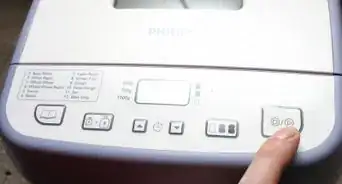This article was co-authored by wikiHow staff writer, Janice Tieperman. Janice is a professional and creative writer who has worked at wikiHow since 2019. With both a B.A. and M.A. in English from East Stroudsburg University, she has a passion for writing a wide variety of content for anyone and everyone. In her free time, you can find her working on a new crochet pattern, listening to true crime podcasts, or tackling a new creative writing project.
The wikiHow Culinary Team also followed the article's instructions and verified that they work.
This article has been viewed 16,317 times.
Learn more...
As delicious as bread may be, no one wants to bite into a stale or moldy slice. If you don’t keep an eye on the temperature and humidity levels of your bread, it’s more likely to go bad at a fast pace.[1] Thankfully, you can use standard household tools and appliances to keep your bread looking and tasting as fresh as possible!
Steps
Opting for Short-Term Storage
-
1Use a breadbox if you plan on eating the bread in 3-4 days. Find a flat, cool, and dry space in your kitchen or eating area to place your box. Arrange 1 or multiple loaves into the breadbox without cramming them into the container.[2] Keep the box closed, and try to eat or use the bread within a few days time.[3]
- You can purchase bread boxes online or in most home goods stores. They’re made from a variety of materials like ceramic, bamboo, and more.
- Breadboxes help provide a slightly humid environment for your bread without a lot of air circulation. This helps keep your bread fresh without it turning stale.
- A microwave can work as an impromptu breadbox, as long as you keep it turned off.[4]
-
2Put a homemade loaf in a paper bag and keep it at room temperature for 2-3 days. Slide your bread loaf into a paper bag before leaving it on a cool, dry, and flat area, like a pantry or countertop. If the bread is already sliced on 1 end, leave the sliced end facing downwards in the bag. Try to keep an exposed or cut parts of the bread covered so the loaf doesn’t go stale.[5]Advertisement
-
3Leave store bought loaves wrapped in plastic at room temperature for 2-3 days. Don’t transfer or rewrap any bread that you’ve purchased at the store, regardless of whether it’s sliced or whole. Instead, keep the loaf wrapped securely in the plastic bag or packaging that it came in. Leave it in a cool, dry, room temperature area where it won’t spoil easily. At this point, continue using this packaging for several days if you plan on eating the bread immediately.[8]
- Avoid storing your bread in warm, moist places, like on top of a refrigerator or dishwasher.
Freezing the Bread
-
1Slide your loaf into a large, freezer-safe bag. Find an airtight, sealable bag that’s large enough to fit your bread loaf comfortably. If you can’t fit the loaf into a single bag, slice it into smaller chunks.[9]
- You can also wrap your bread in plastic or foil before storing it in a freezer-safe bag. However, this isn’t required.[10]
Tip: If you’re freezing sliced bread, place small sections of wax paper between each slice. This will make it easier to separate your bread later on.[11]
-
2Force out any air inside the bag with your hands. Place both hands at the bottom of the bag and begin applying pressure to the plastic. Move your hands upward to guide any extra air out the top. Repeat this process until you can’t feel any air inside the bag.[12]
- If you freeze bread in an air-filled bag, it won’t stay as fresh.
-
3Seal the top of the bag to make it airtight. Use the zipper or seal to completely close off the bag. Once you’ve done this, double-check that your bag is completely closed so your bread isn’t at risk of going bad while in the freezer.[13]
-
4Place the bagged bread in the freezer. Find an empty space in your freezer that’s large enough to fit the sealed bag of bread. Be sure to label the bag with the current date so you can remember when you purchased or prepared the loaf.[14]
-
5Defrost the bread within 2-3 months. Keep an eye on the date listed on your freezer bag in the coming weeks and months.[15] If you want to defrost your bread, open the freezer bag and place it in the refrigerator for 1 night.[16]
- If you defrost your bread on the countertop, the melted water could make the bread soggy.
-
6Reheat any frozen bread at 325 °F (163 °C) for at least 25 minutes. If you’re heating your bread directly out of the freezer, set your oven to a medium-high temperature. Place your loaf in the oven and let it reheat for around 25-30 minutes.[17]
- If you’re reheating frozen slices of bread, feel free to put them in the toaster instead.
Things You’ll Need
Opting for Short-Term Storage
- Breadbox
- Paper bag
- Plastic bag
- Foil (optional)
Freezing the Bread
- Freezer-safe plastic bag
- Permanent marker
References
- ↑ https://www.cnet.com/how-to/how-to-keep-your-bread-fresh-longer/
- ↑ https://www.epicurious.com/expert-advice/how-to-keep-bread-fresh-article
- ↑ https://www.msn.com/en-us/foodanddrink/tipsandtricks/does-a-breadbox-really-keep-bread-fresher/ar-BBPh9ly
- ↑ https://www.cnet.com/how-to/how-to-keep-your-bread-fresh-longer/
- ↑ https://www.foodandwine.com/cooking-techniques/storing-bread-tips
- ↑ https://www.epicurious.com/expert-advice/how-to-keep-bread-fresh-article
- ↑ https://www.stilltasty.com/questions/index/18
- ↑ https://www.insider.com/how-to-store-bread-2019-2
- ↑ https://www.epicurious.com/expert-advice/how-to-keep-bread-fresh-article
- ↑ https://www.insider.com/how-to-store-bread-2019-2
- ↑ https://www.foodandwine.com/cooking-techniques/storing-bread-tips
- ↑ https://www.epicurious.com/expert-advice/how-to-keep-bread-fresh-article
- ↑ https://www.insider.com/how-to-store-bread-2019-2
- ↑ https://www.epicurious.com/expert-advice/how-to-keep-bread-fresh-article
- ↑ https://www.epicurious.com/expert-advice/how-to-keep-bread-fresh-article
- ↑ https://www.foodandwine.com/cooking-techniques/storing-bread-tips
- ↑ https://www.foodandwine.com/cooking-techniques/storing-bread-tips
About This Article
The best way to keep a loaf of bread fresh is to store it properly. Place it in a paper bag or wrap it in foil, then store it at room temperature for 2-3 days. You can also store bread in a bread box, where it will stay fresh for 3-4 days. For long-term storage, freeze the bread. Place it in a large freezer bag, squeeze out any excess air, then seal the bag. Store it in the freezer for up to 3 months. Reheat the bread for 25 minutes at 325°F when you're ready to eat it. For more bread-storing tips and tricks, keep reading the article!






















































